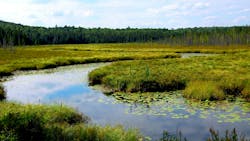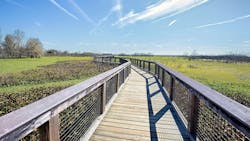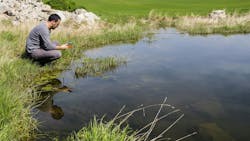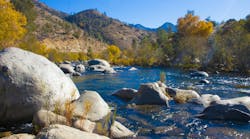Key steps to avoid costly wetland-related delays
Historical snapshot
Wetlands have long been considered an impediment to development, something to be removed and reclaimed to make way for farming, roadways, infrastructure and buildings. A 1990 report to Congress, “Wetlands Losses in the United States, 1780s to 1980s,” stated:
“At the time of Colonial America, the area that now constitutes the 50 united states contained an estimated 392 million acres of wetlands … Over a period of 200 years, the lower 48 states lost an estimated 53% of their original wetlands. The lower 48 states have lost over 60 acres of wetlands for every hour between the 1780s and the 1980s.”[1]
Federal programs incentivized the draining of wetlands for decades. It was not until the advocacy of politically powerful sportsmen looking to preserve their hunting resources, as well as reports from noted biologists and conservationists on the important function of wetlands, that “public attitudes and public policy began to shift from supporting and subsidizing wetland conversion to encouraging wetland conservation and restoration.”[2]
Regulation & enforcement
Federal wetland regulation enacted in the 1970s started to percolate into land development activity in the late 1980s. In the 1990s these regulations started to have real enforcement teeth, and it became incredibly difficult to select a site and permit the design. Failure to consider wetlands when planning project schedules and budgets created costly delays, and in some cases regulatory litigation. The aggressive enforcement by state and federal agencies in the 1990s lead to serious friction with development communities that resulted in a series of landmark U. S. Supreme Court cases that have shaped how wetlands are regulated. This series of Supreme Court decisions have moved the wetlands line but have not eliminated the need to consider wetlands as a critical planning feature.
Impact of the Sackett v. EPA decision
A May 2023 Supreme Court decision[3] in the Sackett v. EPA case, concluded that wetlands regulated by the Clean Water Act (CWA) only include wetlands that have a “continuous surface connection” to other Waters of the U.S. (WOTUS). Among other things, the ruling eliminated certain types of resources from being considered WOTUS — such as isolated wetlands and streams with only ephemeral flow. An ephemeral stream is one that typically only has water flowing through it during and immediately after rain events.
“Estimates of ephemeral streams that could be affected range from 1.2 million miles to 4.9 million miles. And up to 63% of wetlands acres are potentially impacted as mapped in the U.S. by the U.S. Fish and Wildlife Service,”[4] Whitney Beck, Oceans, Wetlands and Communities Division, Office of Water, Environmental Protection Agency, said in a public webinar.
While the Sackett ruling reduced what is regulated by the federal government, it is common for states to have separate wetlands regulations and some local municipalities have their own ordinances on what it defines as wetlands.
The inexperience of young companies just getting into the business, people who decide to develop family land, or opportunists flush with cash when interest rates are friendly can cause their projects to run into the wetlands regulatory buzz saw that will shred a project’s profitability, if not its viability. And while more experienced developers plan for wetland considerations just as they do for problematic waste soils or possible title infractions, there are steps even they can take to better assure their project is spared from costly, wetlands-related setbacks.
Step 1: Look before you buy
Check that the consulting team includes a wetlands scientist with local knowledge. Include a desktop-level screening during the due diligence phase prior to site acquisition. The due diligence consulting team can use its secondary data source system that meshes publicly available data with local experience to identify wetlands and other regulated water features that could be problematic or cost-adding to projects.
If the team does not have its own data source system, it can access commonly available data such as the U.S. Fish and Wildlife’s National Wetlands Inventory Wetlands Mapper, U.S. Department of Agriculture soil data, and the U.S. Geological Survey’s National Hydrology Dataset. Using these sources in concert with aerial photography, a team can develop a working picture of the site’s potential wetland challenges. Some organizations use the same consultant who develops the project’s Phase 1 environmental site assessment (ESA) to also evaluate it for wetlands considerations. This can be a risk if that consulting firm is not trained to synthesize wetland-related data with the lens of someone who understands wetlands permitting. Local knowledge is critical; someone experienced in the region will see subtle signatures on aerial photography that suggest wetland areas not shown on secondary data sets. These same local experts will be familiar with unique state and municipal wetlands regulations that a national consulting firm without a local presence may not know.
Step 2: Avoid impacts to lower cost and save time
If a project can fulfill the same business purpose with a fraction of wetland impacts, it makes sense to do so. Wetland scientists can help a project get there by advising on options to tweak the design in a way that could reduce impacts. That can help the project get into a faster, less expensive permit — in as few as four to six months for a Section 404 Nationwide Permit versus up to two years for a Section 404 Individual Permit.
A nationwide general permit is designed to streamline the U.S. Army Corps of Engineers authorization process for specific project types that have already been determined to have minimal adverse effects. Individual permits are required for projects that do not fit the general permit criteria and involve an individual permitting process which often includes a much more comprehensive environmental analysis and public interest review.
Of course, the best strategy is to avoid wetlands all together. An experienced wetlands scientist can advise the design team on design iterations with an eye to accelerating the permitting process and assure compliance with all requirements.
For every project with potential wetlands impacts, following these best management practices, including working with experienced wetlands scientists who have local knowledge, can help your project head off wetland-related cost and schedule issues.
Sources
1 Report to Congress, Wetlands Losses in the United States, 1780s to 1980s, published 1990, https://www.fws.gov/sites/default/files/documents/Wetlands-Losses-in-the-United-States-1780s-to-1980s.pdf
2 Economic Research Service/USDA Wetlands and Agriculture: Private Interests and Public Benefits
file:///G:/Shared%20drives/Clients/CLIENTS/Terracon/2024/Pitch/WOTUS/USDA%20wetlands%20and%20agriculture.pdf
3 Supreme Court decisions, May 25, 2023 https://www.supremecourt.gov/opinions/22pdf/21-454_4g15.pdf
4 Public Webinar: Updates on the Definition of “Waters of the United States”, September 12, 2023, https://www.youtube.com/watch?v=lcCVelsAy2c
About the Author
Jeremy Hanzlik
Jeremy Hanzlik, P.E., is Terracon’s national director of environmental planning. He has more than 20 years of experience in environmental planning and permitting for private, municipal, and federal clients, including the delivery of NEPA, wetland, protected species, and cultural resource-related projects.
Tom Johnston
Tom Johnston, senior wetland biologist, is a principal at Skelly and Loy, a Terracon company. He is responsible for the coordination of ecological and regulatory services in the mid-Atlantic and New England states and also coordinates the professional development of wetland and permitting staff nationwide. Over nearly 40 years, he has been involved in a wide variety of projects ranging from wetlands investigation to aquatic sampling to terrestrial habitat modeling.




